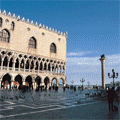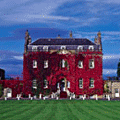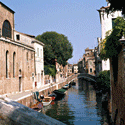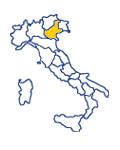|
|
|
Padua Guide Italy
|
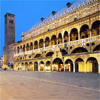 |
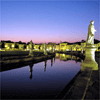 |
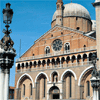 |
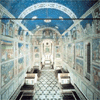 |
| Palazzo della Ragione |
Prato della Valle |
Saint Anthony Basilica |
Scrovegni Chapel |
Directories of Web Sites:
Padua Italy
Padua Hotels
Padua Guide
Padua's origins are very ancient. In the 4th century B.C. it rose from a fishing village to become the most important centre of the Veneto people. Allied with the Romans against the Gauls, it became a Roman Municipium in 45 B.C. and reached a high degree of economic prosperity and great urban development under Augustus.
However, the town suffered a mortal blow when the Longobards set fire to it in 602.
Recovery was slow. At the beginning of the twelfth century Padua was a free Comune and by the second half of the following century (after the parenthesis of the reign of Ezzelino da Romano) it was spreading its influence well beyond the Communal territory, clashing with the emperor, Arrigo VII, and with the La Scala family (1311-1329). During the long war the Da Carrara family came to the fore and was granted seigneury of the town. (1338-1405). During the thirteenth century and for the whole of the fourteenth century the city went through a period of great cultural and artistic fervour. The first circle of walls was built, followed by the Palazzo della Ragione, the Basilica of St. Anthony and the Church of the Eremitani. The University was founded in 1222; it was the second in Italy and attracted teachers and scholars from all over Europe. Both Dante and Petrarchstayed in Padua.
The artistic scene was dominated by Giotto, whose masterpiece is the decoration of the Scrovegni Chapel (1303-1305). Artists such as Guariento, Altichiero and Giusto followed in the wake of the master, creating cycles of frescoes of unparalleled artistry.
The enlightened seigneury of the Da Carrara family came to an end in 1405; Padua fell under the dominion of Venice, whose fate it shared until the end. Padua remained a leader in the artistic field at least till the mid fifteenth century, thanks to the presence of Donatello and Mantegna.
Padua continued its renewal in the sixteenth century: the new circle of fortified walls was built; the new Town Hall, the Palazzo del Capitanio, the imposing Basilica of S. Giustina and the new Cathedral were also built. The University too knew a period of great splendour, with the Botanic Garden and the Anatomy theatre, the new Palazzo del Bo, where Galileo Galilei taught.
During the following three centuries Padua underwent a slow economic decline, reflected in the modesty of private and public buildings. The last great piece of town planning was the rearrangement of Prato della Valle (1775). After the fall of Venice (1797) and the period of Napoleonic rule, Padua passed into Austrian hands (1813) and this situation continued until 1866 when the town was annexed to the kingdom of Italy. Starting from the early years of the twentieth century, a new period of economic growth began, thanks to the development of industry, trade and tertiary services; this trend was strengthened in the period between the two wars and accelerated even more during the last thirty years, thus making Padua the most important managerial pole in North-East Italy.
Scrovegni Chapel holds the most complete cycle of entirely preserved frescoes produced by Giotto(1302-1305). They have mantained all their marvellous beauty! Palazzo della Ragione was built in 1218 by the Commune of Padua as the seat of the Podestà and the Law Courts. The upper floor is occupied by a single hall of exceptional dimensions entirely frescoed with astrological and religious subjects. Basilica of S. Anthony called by the Paduans simply "Santo" is an imposing construction built in the 13th century in Romanesque-Gothic style, with eight domes and belfries of eastern inspiration. It contains the body of St. Anthony. There are works by famous artists (from the 13th to the 20th century) including those of Altichiero, Giusto de' Menabuoi and Donatello. Bo' University was founded in 1222 and with the Univerities of Bologna (the oldest in the world), La Sorbonne (Paris) and the Catholic University of Leuven (Belgium) it is one of the oldest Universities in the world. Here, in 1678 graduated the first woman in the world: Elena Cornaro Piscopia. The large group of buildings was erected between 1542 and 1601 around the medioeval inn of the "Bo" (ox), and has been rearranged several times. The Bo Palace hosts Galilei chair, a rich collection of coats of arms and the famous Anatomy Theatre. Prato della Valle, once a roman theatre, has become the traditional site for fairs and amusements. It is a large elliptical green island, divided by four avenues corresponding to four bridges, surrounded by a canal along which stand 78 statues of famous men. It is one of the largest squares in the Caffé Pedrocchi is a complex building in neoclassical style with a flourish of ornate Gothic, designed by Giuseppe Jappelli (1831). Original and rare example of a multipurpose premises, designed to be a café on the ground floor while the upstairs rooms, decorated in variuous styles, were intended as meeting and concert halls. It is still the most luxurious café in town... a c
The province of Padua is rich in Artistic and Natural Beauties: Este, Montagnana, Cittadella, Monselice, Colli e Terme Euganee are worth a visit.
(Part of the Contents gently given by Provincia di Padova - Photos taken from the CD "Immagini Venete" by Comitato AAPT delle Città d'Arte - Regione Veneto) |
|
|
|
Acquista la tua visibilità su Travel Plan
|
|
|
|

